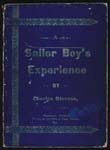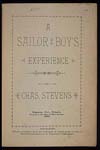Stevens, Charles
Sailor Boy's Experience. Napanee, Ontario. 1892. 107, [1]pp. plus eleven plates (some one-color tinted). This volume is bound in the original printed wrappers, although the spine is chipped and the backstrip is mostly gone.



The author shipped out on the vessel Liverpool and records some of the more interesting side-lights of a seaman's life and duties. Stevens crossed the equator, traveled around the Horn to Peru, and visited the Chincha Islands in the Pacific. Another section details a later voyage to Rio de Janeiro. Stevens then traveled to the West Indies, out of Philadelphia. He was then "smuggled" into the United States Army, leaving one night to cross the border back into Canada. Stevens, in a brief introduction, states that he has "endeavored to present to the reader, Life as I have seen it, and as this work to some extent will fall into the hands of the young, I have refrained from publishing the darker side of my experience; right here let me say I might have inserted some stories that some would call 'Sea Tales', but thought it best to hold to facts as I remembered them, with a little spice thrown in."
The last Chapter deals with a trip to Florida after the Civil War. Stevens purchased a ticket on the Atlantic Coast Line from New York to Orlando, adding that his ticket was about three yards long. He describes his first thoughts as he travels south from Jacksonville:
After resting a few hours in Jacksonville, I took the Jacksonville, Tampa and Key-West Ry. For Orlando, South Florida, passing en route a number of orange groves loaded with luscious fruit, forming a very picturesque scene. The soil along this line of railroad is chiefly sand, and it appears that all the work necessary to build a railroad is to "down" the Georgia pines, grub out the roots, make a ditch on each side and lay the ties and rails....Orlando has a population of about 6,000, is a pretty town and the county seat of Orange county. From what I saw of it and the people, I should think it a very desirable place to live on account of its elevation, it being situated about midway between the Gulf of Mexico on the west, and the Atlantic Ocean on the east; it is also surrounded by numerous lakes. The inhabitants claim it is protected from frosts in the winter and it is cool in the summer on account of the winds which blow from the Gulf and the Ocean.
Stevens eventually ran a successful potash factory and business in Ontario, Canada. The final page of the volume is an advertisement for unbleached hardwood ashes to be used as fertilizer. The ash is "Sold and exported by rail on short notice by Charles Stevens, Napanee, Ontario, Canada." The fragile condition of this volume offers ample explanation to the rarity of the work in library collections. Most of the chapters are illustrated by small drawings on the beginning page and the volume also contains six plates, some of which are printed with colored ink. Two portraits of the author complete the illustrations.